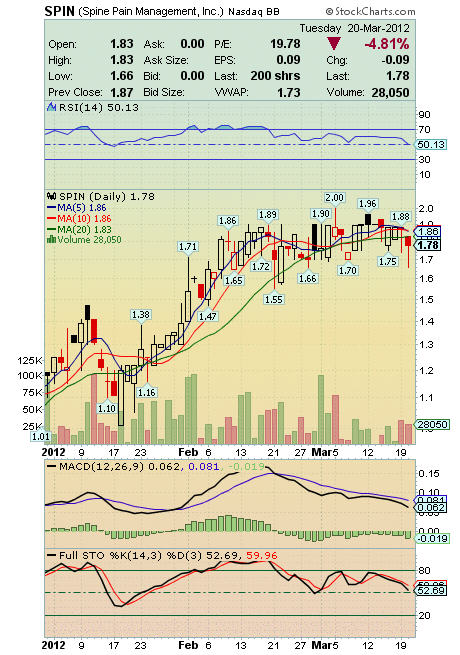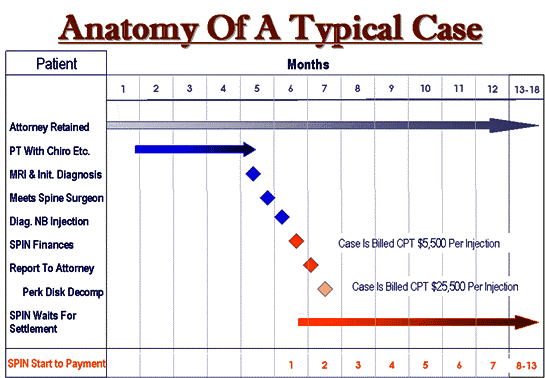 People normally have the same opinion of OTC stocks as they do about ambulance chasing lawyers. They think they are fraudulent and if you get too close to them, you might get “cooties” (Yeah, I went there). But regardless of the title, many of them get the job done and Spine Pain Management, Inc. (OTCBB. SPIN.OB) is no different. Listed on the OTC Bulletin Board as one of the new penny stocks added on February 1, SPIN is so good, the CEO cannot stop buying it. Perhaps it’s because SPIN stock is a good penny stock to buy or because no one has SPIN stock as one of their penny stock picks. Either way, SPIN is one of the healthiest companies I have researched in some time and could be one of the best penny stocks to buy.
People normally have the same opinion of OTC stocks as they do about ambulance chasing lawyers. They think they are fraudulent and if you get too close to them, you might get “cooties” (Yeah, I went there). But regardless of the title, many of them get the job done and Spine Pain Management, Inc. (OTCBB. SPIN.OB) is no different. Listed on the OTC Bulletin Board as one of the new penny stocks added on February 1, SPIN is so good, the CEO cannot stop buying it. Perhaps it’s because SPIN stock is a good penny stock to buy or because no one has SPIN stock as one of their penny stock picks. Either way, SPIN is one of the healthiest companies I have researched in some time and could be one of the best penny stocks to buy.
Everyone who is trading penny stocks or even investing in penny stocks for the “big score” over the long term knows that corporate insiders might sell stock in their company for any number of reasons, but they buy stock in their company for only one; they think the price will go up. I think famous investor Peter Lynch said something along the lines to that. SPIN has been slowly pushing its way up the stock charts and more importantly, the revenue, net operating income and Earnings per share ladder which as any penny stock trader will say: Positive EPS? Are you kidding me? Regardless, if you invest in penny stocks or are looking for cheap penny stocks, keep an eye out on the insider buying news to locate good investment opportunities like SPIN.OB.
![]() Subscribe today and get our next stock alert delivered to your inbox FREE.
Subscribe today and get our next stock alert delivered to your inbox FREE.

Statistics are somewhat outdated regarding spinal cord injuries but nevertheless, the numbers are quite intriguing. According to the National Safety Council and University of Alabama National Spinal Cord Injury Statistical Center:
- There are 6 million reported car accidents in the U.S. annually.
- Over 38,000 of these were fatal and 2.9 million people were injured.
- Over 2.5 million rear end collisions are reported ever year
- 20% of the people involved in rear end collisions exhibit symptoms of cervical strain,
sometimes called “whiplash” injuries. - There are over 3 million neck injuries in the U.S. each year
- The cost of treatment for this has been estimated to run $49 billion annually.
- The most common complaints are neck pain but there are a significant amount of complaints
including shoulder pain, arm pain and low back pain. - 35% of spinal cord injuries are caused by car accidents.
- The majority are males 16-30 years of age.
- 250,000 Americans are spinal cord injured.
- 52% of spinal cord injured individuals are considered paraplegic and 47% quadriplegic.
- Approximately 12,000 new injuries occur each year.
- 82% are male.
- 56% of injuries occur between the ages of 16 and 30.
- The average age of spinal cord injured person is 31.
- SCI injuries are most commonly caused by:
- Vehicular accidents 37%
- Violence 28%
- Falls 21%
- Sports-related 6%
- Other 8%
- 89% of all SCI individuals are discharged from hospitals to a private home, 4.3% are discharged
to nursing homes. - Only 52% of SCI individuals are covered by private health insurance at time of injury.
- Length of initial hospitalization following injury in acute care units: 15 days
- Average stay in rehabilitation unit: 44 days
- Initial hospitalization costs following injury: $140,000
- Average first year expenses for a SCI injury (all groups): $198,000
- First year expenses for paraplegics: $152,000
- First year expenses for quadriplegics: $417,000
- Average lifetime costs for paraplegics, age of injury 25: $428,000
- Average lifetime costs for quadriplegics, age of injury 25: $1.35 million
- Percentage of SCI individuals who are covered by private health insurance at time of injury: 52%
- Percentage of SCI individuals unemployed eight years after injury 63%.
(Note: unemployment rate when stats were compiled was 4.7%)
SPIN Stock Snap Shot:
 Market Cap: 31.04M
Market Cap: 31.04M
Price/Sales (ttm): 6.93
Price/Book (mrq): 9.69
Shares Outstanding: 17.44M
Float: 6.36M
Revenue (ttm): 4.71M
Revenue Per Share (ttm): 0.27
Gross Profit (ttm): 1.96M
Diluted EPS (ttm): 0.09
SPIN stock price has slowly increased since the beginning of 2011 from $0.62 to $1.78, a 187% gain. SPIN stock price actually reached $2 per share on March 5, 2012 which is the closest it has come to matching the all-time high of $2.25 back in December, 2010. In SPIN’s most recent 10-Q filed with the SEC, the balance sheet has $5.73 million in total assets, zero PPE or depreciation and the most significant asset is account receivables (both short and long-term). Even with the profit reported in fiscal year 2010 and most recent 10-Q, the cash flow from operation was negative due to the large increase in the short and long-term accounts receivable which increased revenues without generating any cash flow for SPIN.
The encouraging news of SPIN stock price is that Spine Pain Management’s CEO and 10% owner, William F. Donovan, M.D., has been buying SPIN since June 2008 when the company was known as VersaCard, Inc. dba Spine Pain Management. SPIN and NorthShore Orthopedics, wholly owned by Donovan, reached an agreement a few weeks ago to convert more than $1 million of the outstanding debt owed to NorthShore into SPIN stock at the price of $1.83 per share. In return, SPIN issued 557,000 restricted shares to NorthShore. Call it what you want but that transaction is in every way considered insider trading with the “insider buy” by Donovan, SPIN CEO and 10% owner.
 Spine Pain Management is a niche market business, newly formed as a public company to trade under the ticker symbol SPIN on the OTC Bulletin Board Exchange for nationwide expansion of the business niche that had been developed and successfully deployed for over 3 ½ years by its founders in Houston, TX. Listing publicly in order to expand operations was a move into reaping the rewards of the nearly $50 Billion spinal cord injury market. With an ever expanding market of spine surgeons and orthopedic surgeons, SPIN deals with injured victims who have musculo-skeletal spine injuries and been involved in litigated injury cases. SPIN takes on the responsibilities of assisting injured persons whom are involved in litigation cases by coordinating, streamlining and cost effectively financing their needs with the appropriate medical team to ease recovery of the patient to maximum medical improvement.
Spine Pain Management is a niche market business, newly formed as a public company to trade under the ticker symbol SPIN on the OTC Bulletin Board Exchange for nationwide expansion of the business niche that had been developed and successfully deployed for over 3 ½ years by its founders in Houston, TX. Listing publicly in order to expand operations was a move into reaping the rewards of the nearly $50 Billion spinal cord injury market. With an ever expanding market of spine surgeons and orthopedic surgeons, SPIN deals with injured victims who have musculo-skeletal spine injuries and been involved in litigated injury cases. SPIN takes on the responsibilities of assisting injured persons whom are involved in litigation cases by coordinating, streamlining and cost effectively financing their needs with the appropriate medical team to ease recovery of the patient to maximum medical improvement.
Bottom Line: Spine Pain Management, Inc. (OTCBB: SPIN.OB) is a great penny stock for those looking for long-term value in a cheap, safe stock. Looking deeper into the debt conversion made last month, NorthShore has an agreement of providing medical services as SPIN‘s independent contractor. SPIN‘s outstanding debt to NorthShore was incurred via this agreement. So SPIN‘s CEO and 10% owner, Donovan, has related transactions with SPIN via his wholly owned company NorthShore.
For as long as there are ambulance chasing lawyers and insurance companies that are forced to pay for the damages to those who have injured spinal cords receiving medical treatment, there is a high probability of delivering good returns to SPIN long-term investors. Investors considering SPIN should look beyond the SEC Form 4 filings to understand the real transaction of the insider purchase.
ShareMAR

